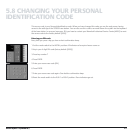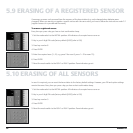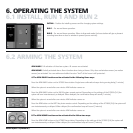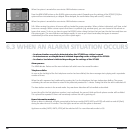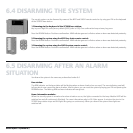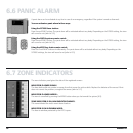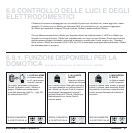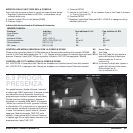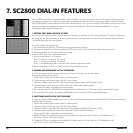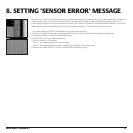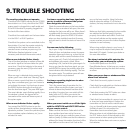
33MS9470/MS9770/MS9970
N.B.: When replacing the batteries of the
sensor when the system is operational, you can
make sure that the sensor maintains its unique
code avoiding re-registration. To do this, you
OPEN the door or window that is protected by
this sensor. After replacing the batteries, you
can close the door or window and the sensor
will instantaneously become part of the system
again. In case this does not work (e.g. the
batteries have been low for too long), you have
to re-install this sensor. You first have to erase
this specific zone (refer to 5.9) and re-register
the sensor (refer to 5.1).
The alarm is activated when pressing the
TEST button but not when a door or
window is opened:
Check that the reed contact and magnet are
properly installed.
Check that the wires between transmitter and
magnet contact are properly connected.
Check that the transmitter of a sensor is not on
or close to a large metal object. Position the
transmitter not on but next to metal frames
(e.g. on the wall) and observe metal supported
synthetic frames. Do not position the
transmitter close to armoured glass.
Check that the gap between magnet and the
reed contact is not too large (10mm on a
wooden and 3mm max on a metal surface).
When you do not hear a short beep from
the base station when pressing the TEST
button during installation of the
door/window or motion sensors:
The sensor is registered with the system
already. You can test this by arming the system
and causing an alarm. Observe that motion
sensors have a reset time between detection of
motions (30-60 seconds).
The sensor is not registered with the system
because it has the same code as another sensor
you are using with the system.
For a DS10 Door/Window Sensor, remove the
batteries and press the TEST button. Reposition
the batteries and press the TEST button for 3
seconds. Set the mode switch of the base
station to INSTALL and register the sensor by
pressing the TEST button.
For an MS10 Motion Sensor, press the CODE
button at the back of the unit with e.g. a
pencil. Set the mode switch of the base station
to INSTALL and register the sensor by pressing
the TEST button.
When the battery indicator of the base
station comes on:
Replace the back-up battery of the base station
(9V block battery). A 9 V alkaline battery lasts
for approx. 12 hours after a mains power
failure. The setting of the base station are
stored in a non-volatile (E2PROM) memory,
which means that all setting of the base station
maintained during power failure and even when
the back-up battery is empty.
When the ARM indicator on the base
station flashes:
This indicates that there has been an alarm. In
case one of the zone indicators flashes also, this
indicates which zone was the source for the
alarm. To reset the base station, you press
DISARM, after entering your PIN. You now can
arm the system again.
When a motion sensor generates an alarm:
Motion sensors are activated by change in
temperature. Do not position motion sensors
close to heat sources, like radiators. Do not
install motion sensors in direct sunlight.
When the base station does not dial out:
Check the telephone connection. Only use the
supplied cables for connecting the base station.
For more information, refer to 4.1 point 3.
Check that all four of the memory positions
have been programmed with a phone number.
Extra siren AS509/PH7208 (optional) does
not sound during an alarm:
The siren is controlled over the mains power
lines but with a delay of 20 to 30 seconds.
When an alarm occurs, the ARM indicator
flashes but the internal siren does not
sound:
The silent alarm mode is programmed in the
settings of the base station. (refer to 5.3).



